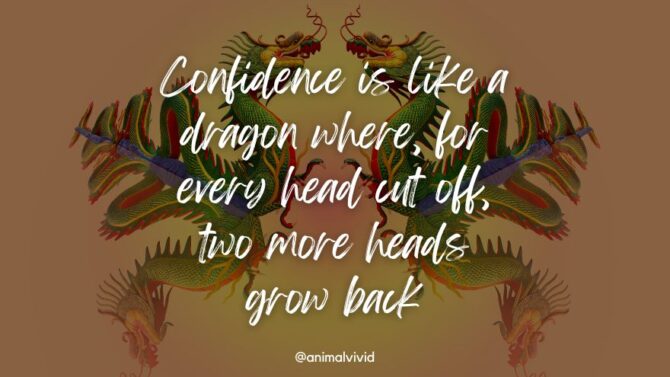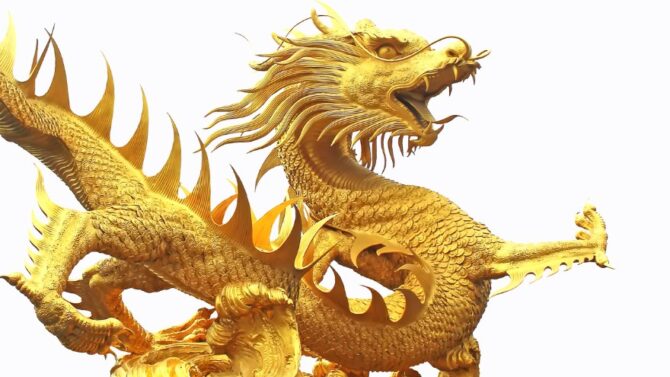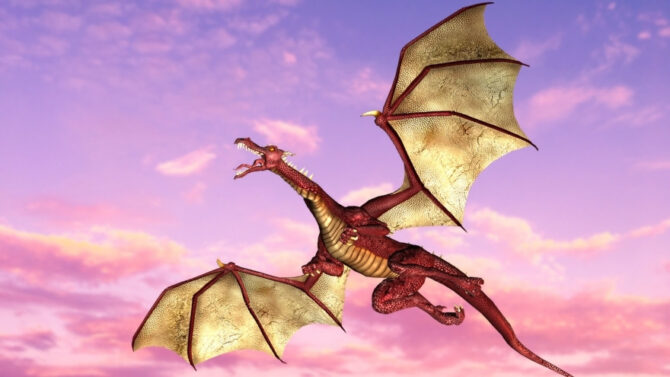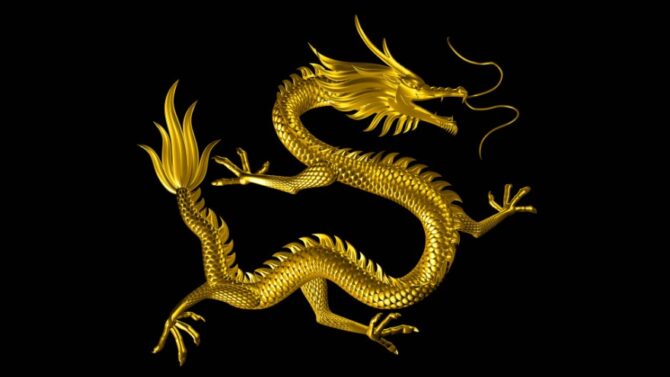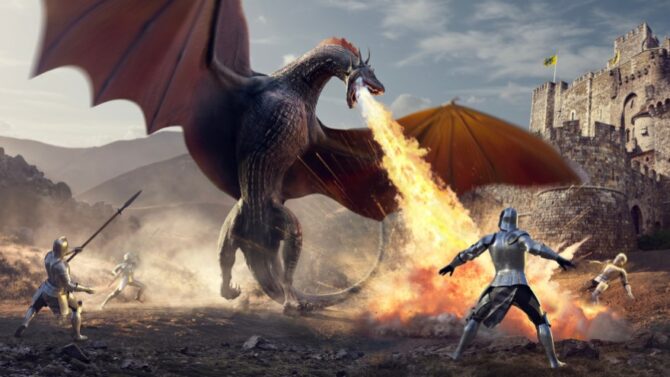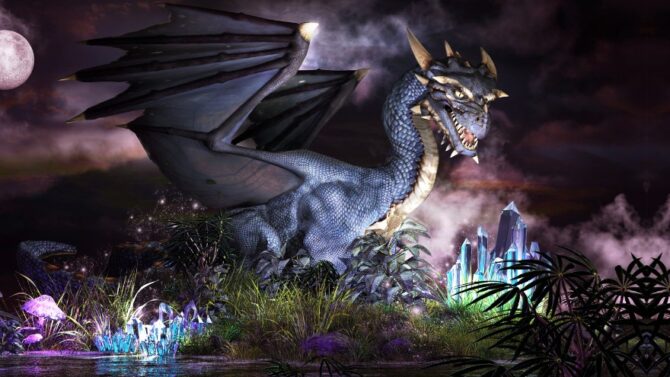Did dragons exist in reality, or were they just a product of human imagination and mythological stories?
Dragons have been a part of human civilization for a long time, living in our writings and oral history.
Their fame won’t disappear soon, especially with movies like Game of Thrones, Harry Potter, and How to Train a Dragon, pushing them more into mainstream culture.
We’ve long accepted that dragons are legendary creatures meant for cinemas, folklores, and bedtime stories.
However, that wasn’t always the case. A brief history of dragons reveals that people believed they were real.
This begs many questions that have intrigued people for centuries, like how did we even know of these creatures? Where did they come from? Did they simply become extinct like dinosaurs?
This article will cover these and more as we unravel the mystery of their existence.
What is a Dragon?
The word “dragon” came into English in the 13th century. It was derived from the Old French dragon, and the french itself is derived from the Latin draconem.
A dragon is commonly depicted as a large, snake-like reptile with wings and some amazing abilities like breathing fire out of its reptile.
However, there are variations to how they look for us to give them a definite biological classification.
They often combine features from different groups, like cats and birds. The extant animal that most resembles a dragon today is the crocodile.
This creature is either depicted as evil or good, depending on where you look to. In the Christian religion, dragons often symbolize the devil and evil forces.
The Chinese have a good image of dragons, but in the general eastern culture, the reputation of this creature is mixed.
Western folklore often portrayed the dragon as a gatekeeper to something valuable or a monster whose defeat represented a victory for the contender.
Did Dragons Exist?
There are modern animals that bear the name “dragon,” like the Komodo dragon and the bearded dragon. However, large flying snake-like creatures such as the type depicted in myths and folklore don’t exist.
At the very least, there has been no concrete evidence that these animals would have walked the earth.
Perhaps if fossil evidence appears sometime in the future, the modern perspective will change.
But as we’ve already mentioned, the creature has been relegated to the realm of mythology.
Ancient scholars considered dragons as real and spoke of them that way.
This belief was rendered more concrete by “fossil” evidence which paleontology has established to be that of dinosaurs and some older extinct animals.
Technology wasn’t as strong then, so with fossil discovery and what was already written about them, it was easy for our predecessors to conclude that these creatures existed.
A Brief History of Dragons
1. Once upon a time…
Where did the knowledge of dragons originate from? There is no absolute answer, but several hypotheses have been developed to attempt to explain their existence.
We do know that the earliest depictions of these reptilian legendary creatures were from the ancient Near East, with myths describing these animals to be large snakes.
They featured in ancient Mesopotamian literature and Art, often serving as villains that needed to be slain.
The Enuma Elish, an old Babylonian creation myth, showed the goddess Tiamat as a dragon.
Of course, Tiamat isn’t the only old famous dragon appearing in ancient writing.
The Hebrew Bible mentions the leviathan and describes it using dragon terms. Egyptian mythology presented Apep as an inhabitant in the underworld (Duat).
It is portrayed as a large snake-like creature. The setting of the sun was said to be caused by the god Ra going to the duat to battle Apep.
Others include the Lernean Hydra in Greek mythology, the Kulshedra in Albanian mythology, and the Fafnir in Norse mythology.
Dragons play an especially big role in Greek mythology, with various heroes going at odds with these beasts.
An example is Jason fighting a gatekeeping dragon to get to the golden fleece.
The aforementioned hydra also battled with Heracles, and even Zeus fought with a dragon.
The Roman civilization is often linked to Greece, so just as their gods are similar (think Zeus and Jupiter), were their Draconian mythology.
Myths from Persia and Iran (Zoroastrian literature) followed the trend of depicting these mythical creatures in a negative light. An example is Azi Dahaka, the symbol of sin and greed.
Chinese mythology is unique in its draconian tales as it presents this creature in a positive light.
They accompanied demigods, brought good fortune, and were a symbol of strength for emperors.
2. Modern Times
This legendary creature continues to be a constant feature in modern literature, movies, and religious texts.
The Christian bible— which combines both Hebrew scriptures and early Christian texts—portrays the dragon in the apocalyptic book of Revelation.
Modern literature uses these creatures mainly in the fantasy genre and children’s literature.
An example of the latter is Lewis Carroll’s Through the Looking Glass, which features the Jabberwock, illustrated comically. Dragons in children’s literature are often harmless and even helpful.
As for the fantasy genre, a notable example is The Hobbit by J.R.R Tolkien.
The character is named Smaug, and it remains one of the most iconic in a classic.
Dragons also feature in the Harry Potter series, as well as George R.R Martin’s A Song of Ice and Fire.
Visual media has also done a good job of engraving the images of this mythical creature in our minds, creatively exploring them.
A popular instance is Game of Thrones, inspired by George R.R Martin’s books.
We also have the animated movie How to Train a Dragon, which displayed them as intelligent—but also ferocious—beings. Then there’s the video game Dungeons and Dragons.
Conclusion
Though dragons may not exist in reality, they certainly live and breathe in our stories and traditions, from myths to folklore down to religious texts.
They were once thought to be real possibly due to discovered dinosaur fossils.
But knowing that there’s no concrete evidence of this creature existing, we have to go with mainstream thought and relegate these creatures to cool series and books.
One thing is for sure, they’ve had their impact on human civilization.
